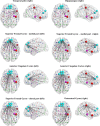Efficiency of weak brain connections support general cognitive functioning
- PMID: 24585433
- PMCID: PMC6869093
- DOI: 10.1002/hbm.22495
Efficiency of weak brain connections support general cognitive functioning
Abstract
Brain network topology provides valuable information on healthy and pathological brain functioning. Novel approaches for brain network analysis have shown an association between topological properties and cognitive functioning. Under the assumption that "stronger is better", the exploration of brain properties has generally focused on the connectivity patterns of the most strongly correlated regions, whereas the role of weaker brain connections has remained obscure for years. Here, we assessed whether the different strength of connections between brain regions may explain individual differences in intelligence. We analyzed-functional connectivity at rest in ninety-eight healthy individuals of different age, and correlated several connectivity measures with full scale, verbal, and performance Intelligent Quotients (IQs). Our results showed that the variance in IQ levels was mostly explained by the distributed communication efficiency of brain networks built using moderately weak, long-distance connections, with only a smaller contribution of stronger connections. The variability in individual IQs was associated with the global efficiency of a pool of regions in the prefrontal lobes, hippocampus, temporal pole, and postcentral gyrus. These findings challenge the traditional view of a prominent role of strong functional brain connections in brain topology, and highlight the importance of both strong and weak connections in determining the functional architecture responsible for human intelligence variability.
Keywords: brain connectivity; comparative psychology; fMRI; functional connectivity; graph theory; intelligence; resting state.
Copyright © 2014 Wiley Periodicals, Inc.
Figures







Similar articles
-
Higher Intelligence Is Associated with Less Task-Related Brain Network Reconfiguration.J Neurosci. 2016 Aug 17;36(33):8551-61. doi: 10.1523/JNEUROSCI.0358-16.2016. J Neurosci. 2016. PMID: 27535904 Free PMC article.
-
Topological organization of functional brain networks in healthy children: differences in relation to age, sex, and intelligence.PLoS One. 2013;8(2):e55347. doi: 10.1371/journal.pone.0055347. Epub 2013 Feb 4. PLoS One. 2013. PMID: 23390528 Free PMC article.
-
Intelligence-related differences in the asymmetry of spontaneous cerebral activity.Hum Brain Mapp. 2015 Sep;36(9):3586-602. doi: 10.1002/hbm.22864. Epub 2015 Jun 8. Hum Brain Mapp. 2015. PMID: 26059228 Free PMC article.
-
Exploring the brain network: a review on resting-state fMRI functional connectivity.Eur Neuropsychopharmacol. 2010 Aug;20(8):519-34. doi: 10.1016/j.euroneuro.2010.03.008. Epub 2010 May 14. Eur Neuropsychopharmacol. 2010. PMID: 20471808 Review.
-
Human connectomics.Curr Opin Neurobiol. 2012 Feb;22(1):144-53. doi: 10.1016/j.conb.2011.08.005. Epub 2011 Sep 9. Curr Opin Neurobiol. 2012. PMID: 21908183 Free PMC article. Review.
Cited by
-
Resting-state electroencephalographic correlates of cognitive reserve: Moderating the age-related worsening in cognitive function.Front Aging Neurosci. 2022 Sep 14;14:854928. doi: 10.3389/fnagi.2022.854928. eCollection 2022. Front Aging Neurosci. 2022. PMID: 36185469 Free PMC article.
-
Performing group-level functional image analyses based on homologous functional regions mapped in individuals.PLoS Biol. 2019 Mar 25;17(3):e2007032. doi: 10.1371/journal.pbio.2007032. eCollection 2019 Mar. PLoS Biol. 2019. PMID: 30908490 Free PMC article.
-
Frequency-specific neuromodulation of local and distant connectivity in aging and episodic memory function.Hum Brain Mapp. 2017 Dec;38(12):5987-6004. doi: 10.1002/hbm.23803. Epub 2017 Sep 8. Hum Brain Mapp. 2017. PMID: 28885757 Free PMC article.
-
Network attributes underlying intellectual giftedness in the developing brain.Sci Rep. 2017 Sep 12;7(1):11321. doi: 10.1038/s41598-017-11593-3. Sci Rep. 2017. PMID: 28900176 Free PMC article.
-
The multiscale self-similarity of the weighted human brain connectome.PLoS Comput Biol. 2025 Apr 7;21(4):e1012848. doi: 10.1371/journal.pcbi.1012848. eCollection 2025 Apr. PLoS Comput Biol. 2025. PMID: 40193851 Free PMC article.
References
-
- Albert R, Jeong H, Barabasi AL (2000): Error and attack tolerance of complex networks. Nature 406:378–382. - PubMed
MeSH terms
LinkOut - more resources
Full Text Sources
Other Literature Sources

